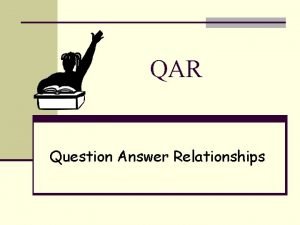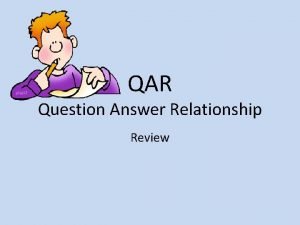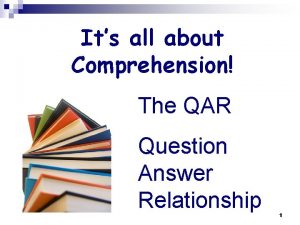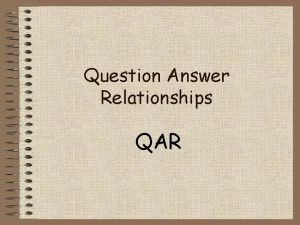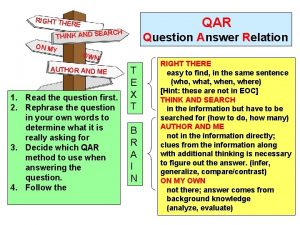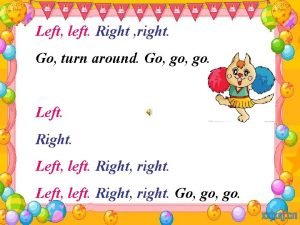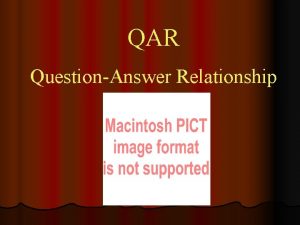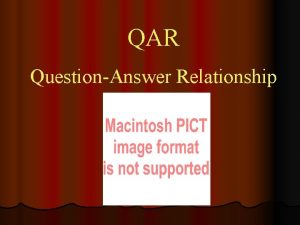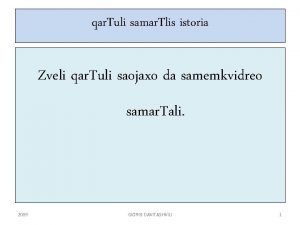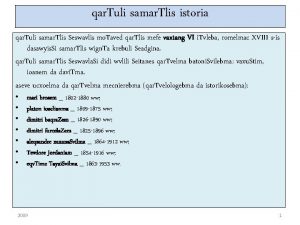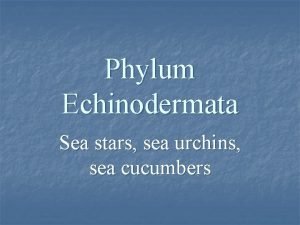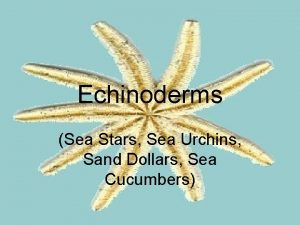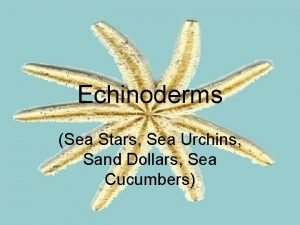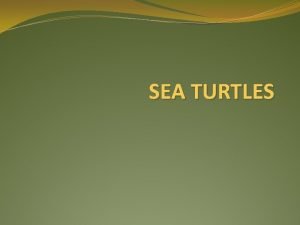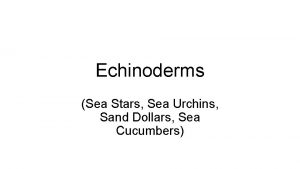QAR RIGHT THE RE THINK AND SEA ON




















- Slides: 20

QAR RIGHT THE RE THINK AND SEA ON MY RCH Question Answer Relation OWN AUTHOR AND ME 1. Read the question first. 2. Rephrase the question in your own words to determine what it is really asking for 3. Decide which QAR method to use when answering the question. 4. Follow the T E X T B R A I N RIGHT THERE easy to find, in the same sentence (who, what, when, where) [Hint: these are not in EOC] THINK AND SEARCH in the information but have to be searched for (how to do, how many) AUTHOR AND ME not in the information directly; clues from the information along with additional thinking is necessary to figure out the answer. (infer, generalize, compare/contrast) ON MY OWN not there; answer comes from background knowledge (analyze, evaluate)

Multiple Choice Questions 1. 2. 2. 3. 4. Use QAR. Read the question. Ask yourself - Do I need the “visual” to answer the question? Read ALL the choices before selecting an answer. Eliminate obviously incorrect answers. Select the MOST CORRECT answer. WATCH FOR: Øcontext clues Øsubject / verb agreement Ønegative words - not, except Øtime sequence - earliest to latest/latest to earliest Ø Does your choice answer the question? What large country today occupies the major portion of the Arabian Peninsula? a. Kuwait c. Sudan b. Iran d. Saudi Arabia

Passage Attack Skills Primary sources, quotes, readings 1. Use QAR. Read the question. What is the question asking? 2. Determine the geographic pattern or process in the quote. 3. LOOK FOR Location reference Time reference ESPN Characteristics (Economic, Social, Political, e. Nvironmental) Point of View 4. Read the answers and eliminate the wrong choices. 5. Choose the MOST CORRECT answer.

Drawing Conclusions & Making Inferences 1. Read the selection carefully to understand all of the facts. 2. Decide the meaning of the selection. 3. Try to find facts in the selection that support your choice for the answer. “Now it seems as though our mother planet is telling us, ‘My children, my dear children, behave in a more harmonious way. My children, please take care of me. ’ ” Dalai Lama * Read to see what is suggested by the facts, but may not actually be stated. * Read between the lines to analyze the selection. From this statement, it can be inferred that Hindus believe in — A. B. C. D. Increasing international trade protecting the environment improving race relations ending poverty and disease

Drawing Conclusions from Multiple Speakers 1. Use QAR. Read the question to identify which speaker(s) is needed to answer the question. 2. Read only the speaker(s) needed to answer the question. 3. Read ALL the possible answers CAREFULLY. 4. Eliminate the answers that do not apply to the speaker(s). 5. Choose the answer that is MOST CORRECT. (Look for key words / synonyms) Speaker W: In my country, families are small and health care is readily available. Speaker X: In my country, the majority of the population lives in urban areas. Speaker Y: In my country, families are large and health services are very limited. Speaker Z: In my country we have many manufacturing and service industries. Speaker Z is describing A. The social structure of a more developed nation. B. The economic base of a less developed nation. C. The social structure of a more developed nation. D. The political structure of a less developed nation.

How to Handle Questions that Have Info You Have Never Seen 1. DO NOT PANIC! Do not focus on the “info” you do not recognize. 2. Focus only on the “info” you know. 3. Use QAR. What is the question asking? 4. Eliminate the answers that do not apply. 5. Choose the MOST CORRECT answer. DEMOGRAPHIC STATISTICS Country New Zealand Panama Papua New Guinea Peru Birth Rate 22 22 34 29 Death Rate 8 25 67 4 18 73 10 63 56 7 Which is the most likely explanation for the infant mortality rate and life expectancy rate in Papua New Guinea? Infant Life Mortality Expectancy 60 66 A. B. C. D. High per capita GDP High literacy rate Harsh climate Limited availability of health care

Examining visuals using the OPTIC system The five letters in the word OPTIC (pertaining to the eye) provide a system for remembering the five steps for analyzing a visual: O is for overview • Conduct a brief overview of the visual. P is for parts • Focus on the parts of the visual. • Read all labels. • Notice any details that seem important. T is for title • Read the title of the visual for a clear understanding of the subject. I is for interrelationships • Use the title to help identify the main idea or the big umbrella that connects the parts of the visual. C is for conclusion • Draw a conclusion about the visual as a whole. What does it mean? -- Why was is included? • Summarize the visual in one or two sentences.

1. Overview= Point of View, general topic/issue/event 2. Parts=Captions & Labels 3. Title 4. Interrelationships= Symbols, Caricatures (exaggerated facial features), Stereotyping 5. Conclusion=MAIN IDEA Political Cartoon OPTIC

Graph OPTIC Bar Graph Line Graph Circle Graphs (Charts) are combinations of symbols, words, and numbers that show information in a clear and simple way. Overview – General data (Economic, Social, Political) Parts – Shading, symbols, legend, axis labels Title-- Read the title Interrelationships. Conclusion-- Identify the main idea

Hints for a pie graph: * the circle represents the whole. * the slices represent parts of the whole (subgroups). Hints for a bar graph: * They commonly measure quantities or amounts of data. * They make it easy to compare information. * Carefully read x and y axes and what they represent. Hints for a line graph: * They commonly measure quantities or amounts of data. *They are used to make more specific comparisons. * Carefully read x and y axes and what they represent.

Interpreting a Population Pyramid • A population pyramid is a bar graph turned on its side. Each line is showing the % of the population is a certain age. • Examine the title and the type of data presented (ex. age breakup, numbers listed below, male-female notation) • =(pyramid) fast growth, lots of babies, less developed • =(tower) steady growth, population evenly distributed, more developed • =(cup) negative growth, population aging, developed

Understanding a Climograph Overview = a look at an area’s monthly average temperature and precipitation Parts= months, temperature line, precipitation bars, legend, scales, metric or standard measurement Title= Location Interrelationships= seasonal sifts, precipitation vs temperature patterns Conclusion=climate type (mid, high, low latitude; polar, temperate, tropical) Months of the year

Comparing/Contrasting Multiple Charts 1. Use QAR What is the question asking? (HINT: You may not need to look at both charts. ) 2. Use OPTIC to “read” data (titles, labels) 3. What patterns or relationships are identified by the data? 4. Eliminate the wrong answers. 5. Choose the MOST CORRECT answer. Which statement best summarizes the information in the charts? A. Life expectancy is longer in Eastern Europe. B. Life expectancy is longer for women in Eastern Europe. C. Life expectancy is shorter, in general, in Eastern Europe. D. Life expectancy is shorter for women in Eastern Europe.

Cause and Effect 1. 2. 3. 4. Use QAR. Read the question carefully - Is it asking for cause or effect? Predict an answer. Read all the choices carefully. Pay close attention to words such as: CAUSE: because as basis for due to since therefore before if EFFECT: consequently leading to resulted in major result affect / effect in response to then after 5. Be sure to notice negative words, such as: except for, is not, excluding. 6. Choose the MOST CORRECT answer.

Cause & Effect Example The Great Potato Famine In 1845, a blight (disease) devastated Ireland’s potato crop, and it returned the next few years. The potato blight was not peculiar to Ireland; in fact, it began in North America. In the midst of the potato famine, corn, cattle, and dairy products continues to be produced in Ireland. But rather than give these foodstuffs to the starving, landlords sold them abroad for profits…. The nation lost a third of its population during the 1845 -1855 famine - more than a million died from starvation or disease. At least another 1 3/4 million fled their native land - 8 in 10 bound for the United States, most of the rest for Canada. The diffusion of the potato blight led to which of the following? A. North America received large numbers of immigrants. B. The potato blight spread to Germany. C. Landlords willingly gave their surpluses of corn and dairy products to the starving people of Ireland. D. Ireland’s population was reduced by half as a result of the potato famine.

Questions Using a Flow Chart Iraq attacks Kuwait and sets oil well fires. Red Adair and like companies are hired. Oil supply from Kuwait drastically reduced. ? • A flow charts shows a series of causes and effects • The first box is a cause of the second statement which is the cause of the third statement and so forth. • The ? box indicates information to be identified. In this case, the missing information could be “Oil prices increase worldwide. ” • Flow chart questions may ask for the missing information, an appropriate title, or for a pattern described in the flow chart.

Identifying Trends These questions involve historical changes over time. These are “big picture” concepts that bridge more than one time period. Migration Diffusion 1. Use historical people, events, and important dates as clues to help you identify the time period. Example: Pre-Columbian After 1492 Exchange 2. Key words are words that imply change, such as: 3. Look for spatial diffusion and/or descriptive words that describe a past pattern impacting the present 4. “has led to” “influenced by” ”describe effects” The BEST answer will logically answer the question. HINT: Does your answer make sense?

Examining Maps Overview = Subject, type of map (phy, political, thematic) Parts = Legend, scale, labels, shading, symbols, inserts Title = Often in legend, frequently includes location, date, and map theme www. lib. utexas. edu/maps Examine the Map’s TODALSIGS Title, Orientation, Date, Author, Legend, Scale, Index, Grid, Symbols Interrelationships = Patterns related to location and map content (such as population density, diffusion path, or vegetation distribution) ; pay attention to key regarding shading (dark is not always more, water is not always blue) Conclusions = Generalizations, trends, or patterns evident from the map information

Recognizing Different Maps Political Map Worldpress. org Cartogram -Actual size/shape changed to reflect data mappery. com Pictorial Map Physical Map Fordham Institute USGS Topographic map of Stowe, Vermont maps. complutense. org NY Subway Map maps-for-free. com

Square, checkerboard or quilt pattern usually indicate agriculture (different greens equal different types of crops) Lighter shades typically indicate sparse vegetation or more shallow water (may also show soil erosion in water) Brown, light tan is usually an indication of soil exposure (as in clearing for development, planting or natural settings such as deserts and beaches) “Reading” GIS Imagery Houston, Texas Rivers, streams, and bayous appear as wavy lines (irregular, wavy=nature). If image has color, water is usually but not always colored blue or dark grey. Darker shades typically indicate thicker vegetation or deeper water Light grey = populations, development, urbanization (straight lines = man made)
 Right product right place right time right price
Right product right place right time right price Family time
Family time Ramaniklal ambani
Ramaniklal ambani The right man on the right place at the right time
The right man on the right place at the right time Qar questions
Qar questions Right there answers
Right there answers Qar questions examples
Qar questions examples Qar test
Qar test Keçdi dəniz aşdı dağ
Keçdi dəniz aşdı dağ Qar visuals
Qar visuals Qar visuals
Qar visuals What is asias largest desert
What is asias largest desert What does the sea symbolize in the old man and the sea
What does the sea symbolize in the old man and the sea A little bird by aileen fisher
A little bird by aileen fisher Think fam think
Think fam think Aegean sea troy
Aegean sea troy Hydra jellyfish sea anemone sea urchin
Hydra jellyfish sea anemone sea urchin Sea cave
Sea cave Left left right right go turn around go go go
Left left right right go turn around go go go Put your right foot in put your right foot out
Put your right foot in put your right foot out Left left right right go go go
Left left right right go go go




